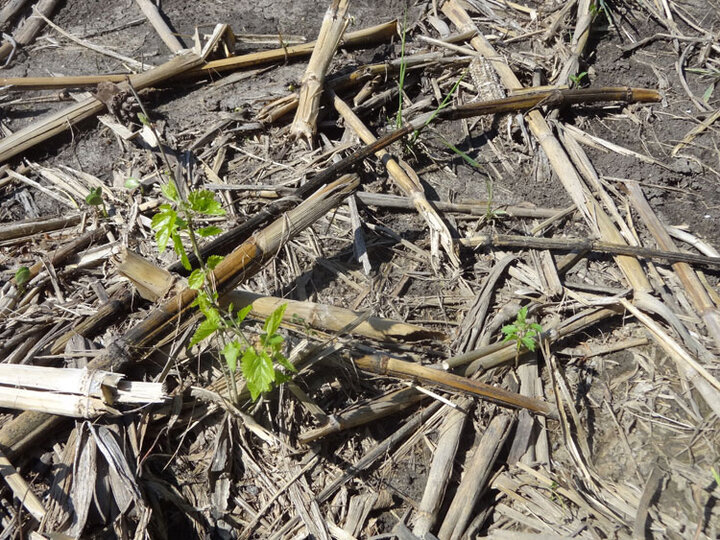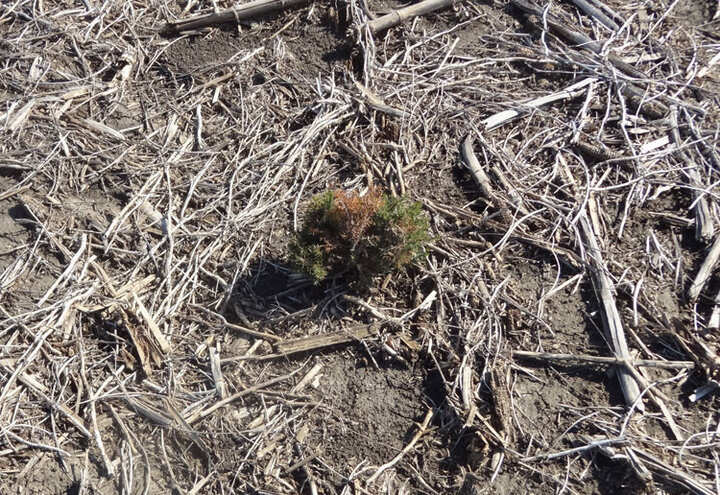Don't Let Tree Seedlings Get Established in No-till Fields
May 21, 2015
Once Seedlings are Well Established
Once tree seedlings and other perennials become established, they are best treated in the fall as they set their winter root reserve. Use a growth regulator, translocated herbicide on actively growing leaves. Check the Guide for Weed Management in Nebraska (EC130) for treatment recommendations. Glyphosate is not very effective on established trees, especially at the rates used in Roundup Ready crops.


Tree seedlings are problem weeds, not caused by no-till, but noticed in no-till production fields once the trees get established. The key is don't let them get started — using residual herbicides reduces the chances.
As a seedling, most trees can be controlled with almost any residual root uptake herbicide. (Atrazine, Callisto, and other broadleaf herbicides are examples.) Several post-emergence and some contact herbicides also work well on seedlings (2,4-D LV ester or dicamba or a very high rate of glyphosate). But once trees become established, they are perennials and should be treated in the fall when they are setting their winter root reserve. Use a translocated herbicide; on cropland the best options are 2,4-D LV ester or dicamba.
Roundup Ready corn and soybean cropping systems with no preplant residual herbicides have really contributed to the problem as many of the seedlings aren't being controlled by glyphosate-only applications. Several new herbicides registered for corn and soybeans are a premix of several existing herbicides. They have multiple modes of action and would provide broad spectrum weed control. (See these CropWatch articles for new corn and soybean herbicides.)
In corn, Hornet can be used post-emergence. Hornet is a combination of clopyralid and flumetsulam. In Roundup Ready corn or Liberty Link corn, Hornet can be tank mixed with glyphosate or Liberty to enhance control. Hornet can be applied post-emergence on corn from the spike to V6 growth stage or up to 20 inches tall. If the trees are creeping in from the field edges, add a full rate of Hornet to your normal herbicide program in the first tank for the field and spray that first tank out around the perimeter of the field. This reduces the cost compared to spraying the entire field with Hornet.
Note: If applying Hornet post-emergence on corn (especially at 4 to 5 oz/ac), there may be some carryover issues if rotating to soybeans the following year. According to the label, if you apply 4.8 oz/ac, the standard rotation interval for soybeans is listed as 10.5 months; however, it continues: "When annual rainfall and/or irrigation is less than 15 inches on soils with less than 2% organic matter, alfalfa, dry beans, lima beans, peas, snap beans, and soybeans should not be planted until 18 months after treatment."In soybeans effective post-emergence herbicide options for established tree control are limited. In Roundup Ready soybeans, the best treatment may be a high rate of glyphosate, which may slow tree growth and development in the first year of application. Then target these trees next year during the corn rotation. All of the recommendations in the "troublesome weeds and woody plants" section of the Nebraska Extension resource Guide for Weed Management in Nebraska contain chemicals in the growth regulator family that will kill soybeans. The Enlist™ corn and soybean weed management system will be commercialized in the near future. (For more information see the CropWatch article, Understanding the Enlist™ Weed Control System.) This will provide an opportunity to use Enlist Duo™, a premix of 2,4-D choline and glyphosate, post-emergence in soybean for control of tree seedlings.
If the tree seedling problem is significant enough to impede or interfere with soybean harvest, producers may need to physically cut and remove the trees. At that time they should apply a stump/basal treatment to the freshly cut material. (Options include using Tordon RTU or a mix of diesel fuel and Grazon; see the cottonwood directions in the Guide for Weed Management.) This would be labor intensive, but running 1-inch or larger sized stems into a bean head cutter bar and the stem and foliage into the combine is not a pretty prospect either. If no basal/stump treatment is applied, producers will still need to plan a herbicide application to target the trees in their corn crop next year as most trees will regrow from the root reserves. Corn is the crop of choice to control these woody species in, since there are a number of the growth regulator herbicides available.
Adding wheat to the rotation gives another opportunity to treat the trees in the fall. Soybean harvest cuts the trees off and doesn't leave enough growth to treat. Late fall sprayings on corn or grain sorghum are probably the most effective as you'll have green leaves present to absorb herbicides. The best advice in soybeans may be to keep after them manually and don't let them spread. Look at your residual programs as well to prevent new ones from getting started.
As in all weed management programs, always read herbicide labels before application.
Paul Jasa, Extension Engineer
Amit Jhala, Extension Weed Management Specialist
